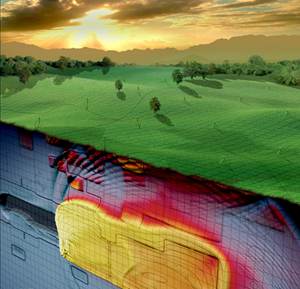|
Scientists at Caltech's Tectonics Observatory have developed a fully dynamic, numerical model that can determine the cyclic pattern of earthquakes at a given location (i.e., the long periods of rest between earthquakes, punctuated by sudden seismic events), if given enough data on both past earthquakes (such as magnitude, location, and date), as well as current rates of slow slippage and seismicity.
The scientists used this model to explain why the 2004 Parkfield earthquake occurred later than expected, and at an unexpected location along the San Andreas Fault.
The scientists focused on the Parkfield area of the San Andreas Fault because it undergoes a variety of distinct behaviors:
- Slow slippage (so slow that humans cannot feel it, though sensitive instruments are able detect it)
- Moderate-sized earthquakes that recur several times within an average human lifetime (and thus allow for model predictions to be tested and retested)
Moreover, this region of the San Andreas Fault has a large historical record of seismic and GPS data.
At Parkfield, stress builds along the fault as the Pacific Plate moves north relative to the North American Plate. The stress is then released, on average, about every 20 years by an earthquake of magnitude between 5.5 and 6.0.
The scientists incorporated laboratory data into the model on how the laws of friction depend on pressures, temperatures, and speeds. And to handle the large range of time scales, the scientists sped up the computation time during the long time periods of quiet in between earthquakes, and then slowed it down during the short bursts of seismicity.
The video below shows a dynamic simulation of the earthquake cycle at Parkfield, generated by this new model. It shows a sequence of two earthquakes, with each earthquake starting at a different end of the seismogenic zone, in agreement with the 1966 and 2004 earthquakes observed at Parkfield.
|

Schematic view inside an earthquake occurring on the Parkfield
segment of the San Andreas Fault, along with an array of GPS stations on the surface to monitor the ground motion - The geological record of past
earthquakes and the continuous monitoring of seismic and aseismic
fault activity allows us to model the entire seismic cycle and
reproduce events such as the 1996 and 2004 Mw 6.0 earthquakes (see video below). Color indicates the slip rate, or speed at which that area along the fault is moving. The yellow area, which ranges from 7 to 10 km in depth, moves the fastest, 0.1 meters/second. This speed, called the "seismic speed," is the minimum speed required to generate seismic waves large enough to be felt by humans. Black areas are locked, which means they are not moving. And blue areas are moving at the average speed of the tectonic plate (in this case about 3 cm/year). The ripples seen in the color pattern indicate the motion of the seismic waves. The rupture is moving to the left, away from the reader.
|
|

